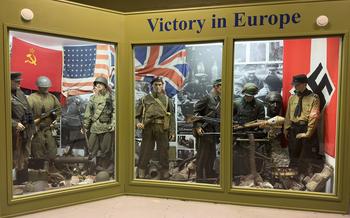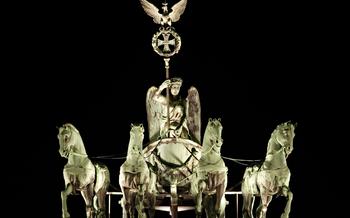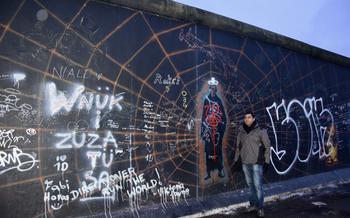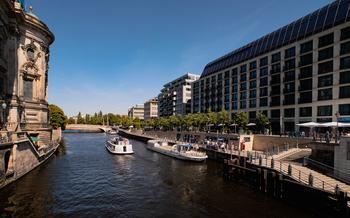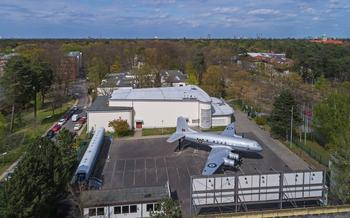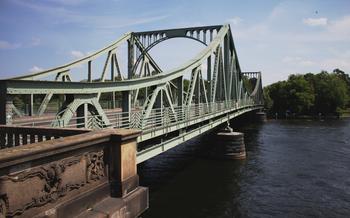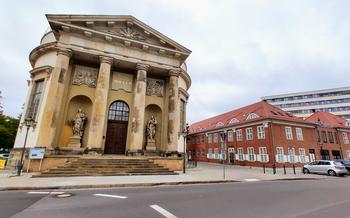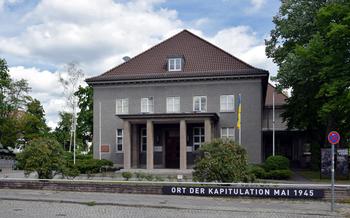
Checkpoint Charlie
- Historical Significance
- Location
- Visiting Hours and Ticket Prices
- The Museum at Checkpoint Charlie
- The Guardhouse
- The Checkpoint Charlie Monument
- The Path of Freedom
- The Black Box Project
- Guided Tours
- Photography and Social Media:
- Souvenirs and Merchandise:
- Accessibility
- Tips for Visiting
- Historical Walking Tours:
- Insider Tip: The Secret Tunnel of Checkpoint Charlie
Historical Significance
Checkpoint Charlie stands as a testament to the Cold War's division and the resilience of the human spirit. Once a bustling crossing point between East and West Berlin, it symbolized the ideological divide that separated families, friends, and nations. During its operation from 1961 to 1990, Checkpoint Charlie witnessed countless attempts to cross the Berlin Wall, some successful and some tragic. The stories of those who risked their lives to escape oppression and seek freedom form an integral part of the site's historical significance.
The symbolism of Checkpoint Charlie transcends its physical presence. It represents the struggle for freedom, the yearning for reunification, and the triumph of human will over adversity. Its transformation from a site of division to a symbol of unity serves as a reminder of history's complexities and the enduring power of hope. Today, Checkpoint Charlie stands as a poignant reminder of the past and a symbol of reconciliation, inviting visitors to reflect on the profound impact of the Berlin Wall and the lessons it holds for humanity.
Location
The legendary Checkpoint Charlie is strategically situated at the junction of Friedrichstraße and Zimmerstraße in Berlin's bustling Mitte district. This iconic intersection has borne witness to countless historical events and stands as a poignant reminder of the city's tumultuous past. Checkpoint Charlie's proximity to other significant landmarks makes it an ideal starting point for exploring Berlin's rich cultural heritage. A short stroll away, visitors can marvel at the grandeur of the Brandenburg Gate, a symbol of German reunification, or immerse themselves in the poignant history of the Jewish Museum Berlin. The vibrant Gendarmenmarkt square, with its majestic concert halls and historic churches, is also within easy reach. Whether on foot or using Berlin's efficient public transport system, Checkpoint Charlie's central location ensures effortless accessibility for travelers seeking to delve into the heart of Berlin's captivating history.
Visiting Hours and Ticket Prices
The current operating hours of the Checkpoint Charlie Museum are from 9 am to 9 pm every day of the week, including public holidays. This schedule allows visitors the flexibility to plan their visit at their convenience. Admission fees are set at a reasonable rate, with standard tickets priced at 50 euros for adults, 50 euros for students, and 50 euros for children between the ages of 6 and Seniors over the age of 65 can also avail of a reduced rate of 50 euros.
To enhance the visitor experience, online booking is highly recommended, especially during peak tourist seasons or for groups. Advance reservations not only guarantee entry but also offer discounted rates. Online tickets can be purchased through the museum's website or reputable third-party platforms.
The Museum at Checkpoint Charlie
The Museum at Checkpoint Charlie offers a comprehensive exploration of the history of the Berlin Wall and its impact on the lives of individuals. Through a variety of exhibits and displays, the museum delves into the complexities of the division and the human stories behind it. Visitors can trace the timeline of the Berlin Wall's construction, its significance as a symbol of Cold War tensions, and the eventual reunification of Germany.
Artifacts, photographs, and multimedia presentations bring to life the experiences of those who lived under the shadow of the wall. Personal stories of escape attempts, family separations, and acts of resistance highlight the human toll of the division. The museum also showcases the role of Checkpoint Charlie as a focal point for international diplomacy and negotiations, as well as the pivotal events that led to the fall of the Berlin Wall.
Among the highlights of the museum's collection are authentic guard tower equipment, surveillance cameras, and uniforms used by border guards. Visitors can also view sections of the original Berlin Wall, including graffiti and markings that symbolize the struggle for freedom. The museum serves as a powerful reminder of the courage and determination of those who fought for a unified Germany and a world without barriers.
The Guardhouse
The guardhouse at Checkpoint Charlie stands as a stark reminder of the oppressive control exerted during the Cold War. Constructed in 1961, this imposing structure served as the primary checkpoint for foreigners and diplomats crossing between East and West Berlin. Its design, characterized by the GDR's distinctive socialist architectural style, exudes an aura of authority and surveillance. Inside the guardhouse, visitors can explore the cramped and dimly lit rooms where border guards meticulously checked passports and scrutinized travelers' belongings. These rooms, now preserved as part of the museum, offer a glimpse into the tense and often-fraught atmosphere that permeated this critical crossing point.
During its operation, the guardhouse witnessed numerous dramatic events and confrontations. In 1963, a tense standoff ensued when a Soviet tank and an American tank faced off at the checkpoint, a moment that brought the world to the brink of nuclear war. The guardhouse also played a role in several daring escape attempts, as individuals desperate for freedom risked their lives to cross the border. These stories, both tragic and triumphant, are recounted in detail within the museum's exhibits, shedding light on the human toll of the division.
The Checkpoint Charlie Monument
Standing as a stark reminder of the division and subsequent reunification of Berlin, the Checkpoint Charlie Monument is an iconic symbol that has become synonymous with the site. Designed by artists Frank Thiel and Andreas Van der Straeten, the monument features three white pillars standing tall, each representing a different era in the city's history. The pillars are adorned with illuminating cut-outs depicting scenes of division, escape, and reunification, creating a profound visual impact.
The monument serves as a poignant memorial to the resilience, determination, and eventual triumph over oppression. It honors the countless individuals who risked their lives to escape East Berlin, as well as those who worked tirelessly to bring down the Berlin Wall. Visitors can wander through the pillars, experiencing a powerful emotional journey as they contemplate the significance of this historic site.
One of the most compelling aspects of the monument is its interactive nature. Visitors are invited to trace their fingers along the cut-outs, creating a tactile connection with the stories depicted. This interactive element adds a deeply personal dimension to the experience, allowing visitors to engage with the history and feel a sense of connection to the individuals who lived through these tumultuous times.
The Checkpoint Charlie Monument is a must-see for anyone interested in learning more about the history of the Berlin Wall and the reunification of Germany. It stands as a powerful testament to the human spirit's ability to overcome adversity and serves as a reminder that freedom and unity should never be taken for granted.
The Path of Freedom
Amidst the remnants of the Berlin Wall, a cobblestone path known as the Path of Freedom emerges as a poignant reminder of the divided city's struggle for reunification. This symbolic walkway, located directly adjacent to Checkpoint Charlie, marks the route successfully taken by numerous individuals who dared to cross the treacherous border between East and West Berlin.
The Path of Freedom serves as a testament to the indomitable spirit of those who risked everything to escape the oppressive grip of the communist regime. Each cobblestone bears witness to the stories of courage, determination, and the yearning for a better life that fueled their perilous journeys.
The path's strategic positioning, running parallel to the Berlin Wall, allowed individuals to navigate the treacherous terrain between the heavily guarded checkpoints. With every step taken, they defied the iron curtain that sought to divide families, friends, and an entire nation.
Today, the Path of Freedom stands as a powerful symbol of resilience and triumph. It invites visitors to reflect on the countless sacrifices made by those who sought freedom, reminding them of the lengths to which people will go to break free from oppression.
The Black Box Project
The Black Box Project is a captivating interactive multimedia installation that delves into the poignant stories of individuals who were directly affected by the Berlin Wall's division. Through a series of personal testimonies and immersive experiences, visitors can gain a profound understanding of the human toll exacted by this tumultuous period.
The Black Box features a collection of poignant interviews with individuals who lived through the division, recounting their personal experiences and struggles. Their heart-wrenching accounts offer a glimpse into the complexities of life under the shadow of the Berlin Wall, shedding light on the emotional and psychological toll it took on both East and West Berliners.
In addition to personal testimonies, the Black Box also showcases historical footage and documents that provide a comprehensive overview of the Berlin Wall's construction, its impact on the city, and the events leading to its eventual fall. These visual and auditory elements help to contextualize the personal stories and provide a deeper understanding of the historical significance of the Berlin Wall.
Through the Black Box Project, visitors are invited to engage with the past in a deeply personal and immersive way. The combination of personal stories, historical footage, and interactive elements creates a powerful and moving experience that leaves a lasting impression on all who visit.
Guided Tours
For a more immersive and comprehensive experience, consider booking a guided tour at Checkpoint Charlie. Knowledgeable guides, often fluent in multiple languages, lead these tours, providing in-depth insights into the historical significance, symbolism, and personal stories related to the site.
Joining a guided tour offers several advantages. Guides provide historical context, explain the exhibits, and share anecdotes that bring the past to life. They can also point out hidden details and answer any questions you may have. Guided tours typically last for about an hour and are available at various times throughout the day.
Advance booking is recommended, especially during peak tourist seasons, to secure your spot. Group discounts may be available, making it a cost-effective option for larger groups or families. Whether you're a history buff, a curious traveler, or simply want to learn more about this iconic site, a guided tour at Checkpoint Charlie is an excellent way to delve deeper into its captivating history.
Photography and Social Media:
Capture the essence of Checkpoint Charlie through your lens and share your experience with the world. Snap photos of the iconic guardhouse, the moving memorials, and the poignant street art that adorns the surrounding walls. Don't forget to include the symbolic cobblestones of the Path of Freedom, representing the countless journeys of those who dared to cross. Use relevant hashtags like #CheckpointCharlie, #BerlinWall, and #HistoryUncovered to connect with fellow travelers and history enthusiasts. Share your thoughts, emotions, and stories on social media, helping to keep the memory of this pivotal site alive. Discover Instagrammable spots around the area, such as the nearby East Side Gallery, where colorful murals adorn the remaining sections of the Berlin Wall. Your photos and social media posts will not only document your visit but also contribute to the collective memory of this significant chapter in history.
Souvenirs and Merchandise:
At Checkpoint Charlie, you can immerse yourself in history while browsing through a range of souvenirs and merchandise that capture the essence of the site and the Berlin Wall era. From postcards and magnets featuring iconic images to replicas of the checkpoint signs, there's something for every visitor to take home as a memento.
Within the museum, you'll find a dedicated shop offering an extensive collection of souvenirs, including books, documentaries, and other publications that delve deeper into the history of the Berlin Wall and Checkpoint Charlie. These items provide valuable insights and perspectives on the division and reunification of Berlin, allowing you to continue your exploration beyond your visit.
If you're looking for a unique souvenir, consider purchasing a piece of the actual Berlin Wall. Fragments of the wall are available for purchase at various shops and online retailers, each carrying a piece of history and symbolizing the fall of the oppressive regime.
Whether you choose a tangible souvenir or a piece of literature, your purchase contributes to preserving the memory of Checkpoint Charlie and the Berlin Wall, ensuring that their stories continue to be told and remembered for generations to come.
Accessibility
Checkpoint Charlie is committed to ensuring that all visitors, regardless of their abilities, can have a fulfilling and educational experience. Wheelchair accessibility is a top priority, with designated routes and ramps throughout the museum and surrounding areas. Visitors with hearing impairments can take advantage of audio guides or transcripts to enhance their understanding of the exhibits. Additionally, staff members are always available to provide assistance and ensure that everyone feels welcome and accommodated.
Tips for Visiting
To make the most of your visit to Checkpoint Charlie, consider arriving early in the morning or later in the afternoon to avoid the crowds that gather during peak hours. Combine your visit with other nearby attractions, such as the Topography of Terror, the Brandenburg Gate, or the Jewish Museum, to create a comprehensive historical experience. After exploring the museum and the surrounding area, take a break at one of the many cafes or restaurants nearby to savor the local cuisine and soak up the vibrant atmosphere of Berlin.
Historical Walking Tours:
To delve deeper into the history of the Berlin Wall, visitors can embark on one of the many guided walking tours that focus specifically on this topic. These tours provide an opportunity to learn about the construction of the wall, the lives of those who lived on either side of it, and the events that led to its eventual fall. Many of these tours include a visit to Checkpoint Charlie as a significant stop, allowing visitors to see the site where the wall once stood and hear stories about the people who tried to cross it. Through these walking tours, visitors can gain a comprehensive understanding of the Berlin Wall's impact on the city and its people, and appreciate the significance of Checkpoint Charlie as a symbol of both division and unity.
Insider Tip: The Secret Tunnel of Checkpoint Charlie
For history buffs eager to dig deeper into Checkpoint Charlie's secrets, venture into the captivating world of the secret tunnel. While not officially open to the public, rumors and tales surround a hidden escape route once used by Allied forces. Seek out local guides or historians who can provide insights and perhaps arrange a private tour of this enigmatic underground passage. Experience the thrill of exploring a hidden relic of the Cold War era, where history unfolds in the most unexpected ways.
